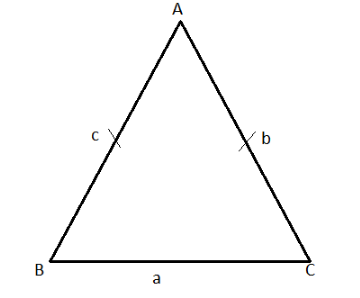
The perimeter of an isosceles triangle is equal to $ 14\;cm $ , the lateral side is to the base in the ratio $ 5:4 $ . The area of the triangle is:
Answer
557.4k+ views
Hint: An isosceles triangle is the triangle in which the lengths of the two sides of the triangle are always equal. Here we will consider the variable “x” and by using the heron’s formula will find the area of the triangle. To use Heron’s formula, we will first find the semi-perimeter of the triangle “s”.
Complete step-by-step answer:

Let us consider the lateral side of the triangle be $ = 5x $
And the base side of the triangle be $ = 4x $
Now, we know that the perimeter of the triangle is equal to the sum of all the three sides of the triangle.
Also, perimeter is equal to $ 14\;cm $ (Given)
Therefore, $ 5x + 5x + 4x = 14 $
Simplify the above equation and find the value of “x”
$ \Rightarrow 14x = 14 $
When the term in the multiplicative at one side is moved to the other side, then it goes to the division.
$
\Rightarrow x = \dfrac{{14}}{{14}} \\
\Rightarrow x = 1 \\
$
Now, the semi-perimeter is half of the perimeter.
$ \Rightarrow s = \dfrac{p}{2} $
Place the value-
$
\Rightarrow s = \dfrac{{14}}{2} \\
\Rightarrow s = 7\;cm \;
$
Area of Triangle, Now, using the Heron’s formula –
$ A = \sqrt {s(s - a)(s - b)(s - c)} $
Where “a” is the measure of the side “BC”
“b” is the measure of the side “AC”
“c” is the measure of the side “AB”
Now, place the values in the above equation –
$ A = \sqrt {7(7 - 5)(7 - 5)(7 - 4)} $
Simplify the above equation –
$ A = \sqrt {7(2)(2)(3)} $
Take one time outside the square since the multiple of the same number inside square root cancel one time when taken outside the square-root
$ A = 2\sqrt {21}\; c{m^2} $
Hence, the area of the triangle is $ 2\sqrt {21}\; c{m^2} $
So, the correct answer is “$ 2\sqrt {21}\; c{m^2} $”.
Note: Heron’s formula was created by Heron of Alexandria. It is also known as Heron's formula. This formula is most widely used where all the sides of the triangle are known and without knowing its angles.
Complete step-by-step answer:

Let us consider the lateral side of the triangle be $ = 5x $
And the base side of the triangle be $ = 4x $
Now, we know that the perimeter of the triangle is equal to the sum of all the three sides of the triangle.
Also, perimeter is equal to $ 14\;cm $ (Given)
Therefore, $ 5x + 5x + 4x = 14 $
Simplify the above equation and find the value of “x”
$ \Rightarrow 14x = 14 $
When the term in the multiplicative at one side is moved to the other side, then it goes to the division.
$
\Rightarrow x = \dfrac{{14}}{{14}} \\
\Rightarrow x = 1 \\
$
Now, the semi-perimeter is half of the perimeter.
$ \Rightarrow s = \dfrac{p}{2} $
Place the value-
$
\Rightarrow s = \dfrac{{14}}{2} \\
\Rightarrow s = 7\;cm \;
$
Area of Triangle, Now, using the Heron’s formula –
$ A = \sqrt {s(s - a)(s - b)(s - c)} $
Where “a” is the measure of the side “BC”
“b” is the measure of the side “AC”
“c” is the measure of the side “AB”
Now, place the values in the above equation –
$ A = \sqrt {7(7 - 5)(7 - 5)(7 - 4)} $
Simplify the above equation –
$ A = \sqrt {7(2)(2)(3)} $
Take one time outside the square since the multiple of the same number inside square root cancel one time when taken outside the square-root
$ A = 2\sqrt {21}\; c{m^2} $
Hence, the area of the triangle is $ 2\sqrt {21}\; c{m^2} $
So, the correct answer is “$ 2\sqrt {21}\; c{m^2} $”.
Note: Heron’s formula was created by Heron of Alexandria. It is also known as Heron's formula. This formula is most widely used where all the sides of the triangle are known and without knowing its angles.
Recently Updated Pages
Master Class 9 Social Science: Engaging Questions & Answers for Success

Master Class 9 Science: Engaging Questions & Answers for Success

Master Class 9 English: Engaging Questions & Answers for Success

Master Class 9 Maths: Engaging Questions & Answers for Success

Master Class 9 General Knowledge: Engaging Questions & Answers for Success

Class 9 Question and Answer - Your Ultimate Solutions Guide

Trending doubts
Which places in India experience sunrise first and class 9 social science CBSE

Fill the blanks with the suitable prepositions 1 The class 9 english CBSE

Write the 6 fundamental rights of India and explain in detail

Difference Between Plant Cell and Animal Cell

What is pollution? How many types of pollution? Define it

What is the Full Form of ISI and RAW





